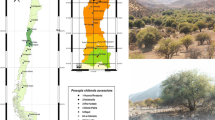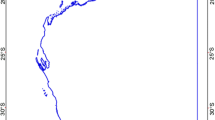Abstract
A fieldsurvey was made to elucidate whether salt spray is a major factor in preventing a common inland weed,Solidago altissima, from being established on the seashore of Boso Peninsula. Seasonal changes in the intensity of salt spray, sodium content in the soil water and soil water contents were measured at the seashore and inland. Seeds ofS. altissima were sown at both sites with those of a common maritime species,Chrysanthemum pacificum. The number of surviving shoots of the seedlings were periodically counted for 1 year. The intensity of the salt spray, sodium content and water contents of the soil on the seashore fluctuated seasonally. There were some periods when the intensity of salt spray was comparable to that of the inland site. Most of theS. altissima seedlings survived at the inland site. AllS. altissima seedlings germinated at the seashore were completely eliminated. The death rate ofS altissima seedlings at the seashore was not constant. Ninety-five percent of theS. altissima seedling in total died out during the four periods of intensive salt spray. The death rate ofC. pacificum seedlings on the seashore was not especially high during those periods. Correlation between seasonal changes in the death rate ofS. altissima seedlings and the sodium content or water content of the soil was low. These results indicate that intensive salt spray, intermittently blown in from the sea, is one of the most critical environmental factors that eliminatesS. altissima from the seashore.
Similar content being viewed by others
References
Barbour M. G. (1978) Salt spray as a microenvironmental factor in the distribution of beach plants at Point Reyes, California.Oecologia 32: 213–224.
Boyce S. G. (1954) The salt spray community.Ecological Monographs 24: 29–67.
Eaton T. E. (1979) Natural and artificially altered patterns of salt spray across a forested barrier island.Atmospheric Environment 13: 705–709.
Edward R. S. &Claxton S. M. (1964) The distribution of air-borne salt of marine origin in the Aberystwyth area.Journal of Applied Ecology 1: 253–264.
Fujiwara K. &Umejima S. (1962) On the distribution of wind-borne salt on the coastal terrace.Research Bulletin of the College of Experimental Forests, Hokkaido University 21: 453–464. (in Japanese with English summary).
Grimshaw H. M., Allen S. E. &Parkinson J. A. (1989) Nutrient elements. In:Chemical Analysis of Ecological Materials. 2nd ed. (ed. S. E. Allen) pp. 81–159. Blackwell Science, London.
Marschner H. (1986)Mineral Nutrition of Higher Plants. Academic Press, London.
Maruta E. (1976) Seedling establishment ofPolygonum cuspidatum on Mt Fuji.Japanese Journal of Ecology 26: 101–105.
Moss A. E. (1940) Effect on trees of wind-driven salt water.Journal of Forestry 38: 421–425.
Numata M., Shimada T. &Nagasima H. (1948) Tolerance to wind-borne salt of plants at the sea-side.Botanical Magazine Tokyo 61: 721–726 (in Japanese).
Oosting H. J. (1945) Tolerance to salt spray of plants of coastal dunes.Ecology 26: 85–89.
Oosting H. J. &Billings W. D. (1942) Factors effecting vegetational zonation on coastal dunes.Ecology 23: 131–142.
Randall R. E. (1970) Salt measurement on the coast of Barbados, West Indies.Oikos 21: 65–70.
Sloet Van Oldruittenborgh C. J. M. &Heeres E. (1969) On the contribution of air-borne salt to the gradient character of the Voorne dune area.Acta Botanica Neerlandica 18: 315–324.
Wells B. W. &Shunk I. V. (1937) Seaside shrubs: wind forms vs. spray forms.Science 85: 499.
Yura H. (1988) Comparative ecophysiology ofLarix kaempferi (Lamb.) Carr. &Abies veitchii Lindl. 1. Seedling establishment on bare ground on Mt Fuji.Ecological Research 3: 67–73.
Author information
Authors and Affiliations
About this article
Cite this article
Yura, H. Comparative ecophysiology ofChrysanthemum pacificum Nakai andsolidago altissima L. 1. whyS. altissima cannot be established on the seashore. Ecol. Res. 12, 313–323 (1997). https://doi.org/10.1007/BF02529461
Received:
Issue Date:
DOI: https://doi.org/10.1007/BF02529461




